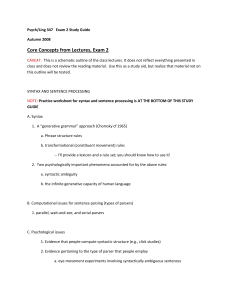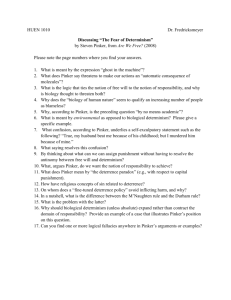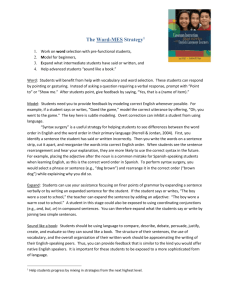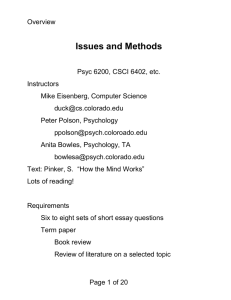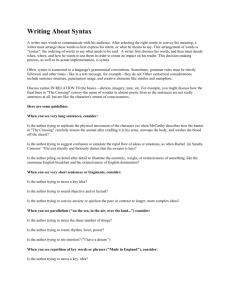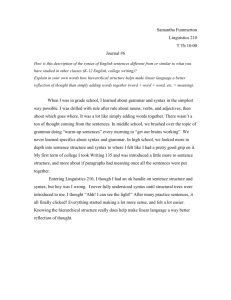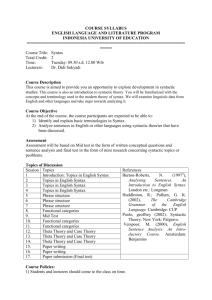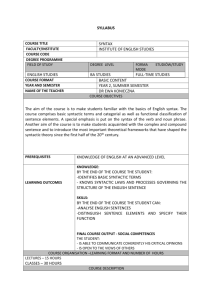Psych/Ling 347 Exam 2 Study Guide Autumn 2009 Core Concepts
advertisement
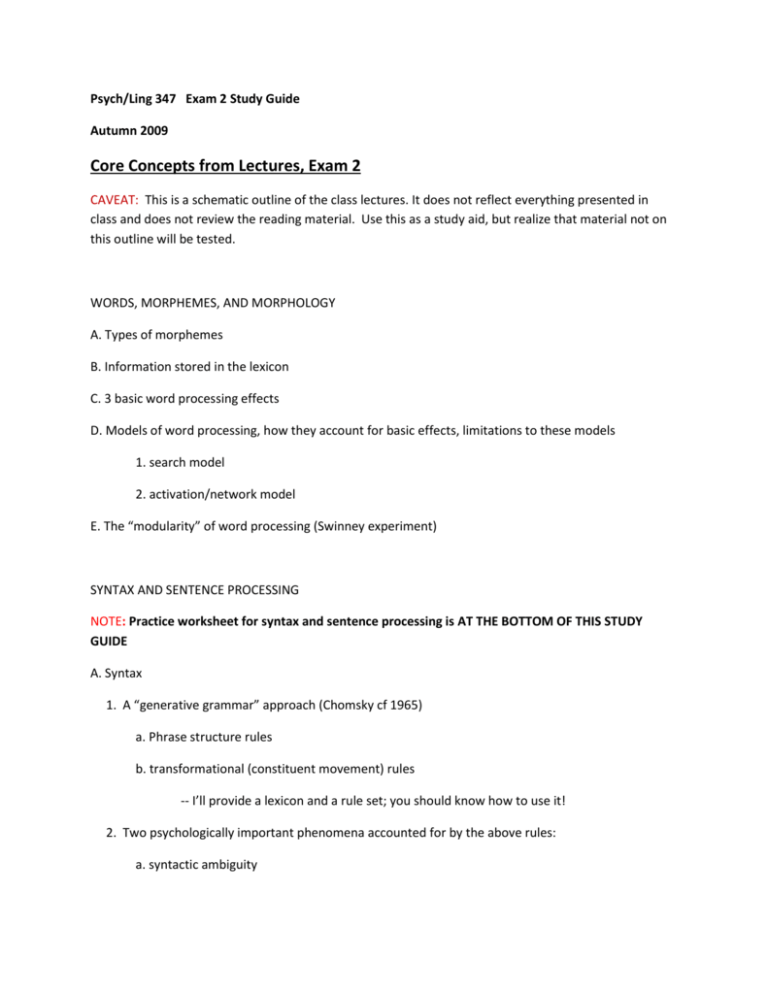
Psych/Ling 347 Exam 2 Study Guide Autumn 2009 Core Concepts from Lectures, Exam 2 CAVEAT: This is a schematic outline of the class lectures. It does not reflect everything presented in class and does not review the reading material. Use this as a study aid, but realize that material not on this outline will be tested. WORDS, MORPHEMES, AND MORPHOLOGY A. Types of morphemes B. Information stored in the lexicon C. 3 basic word processing effects D. Models of word processing, how they account for basic effects, limitations to these models 1. search model 2. activation/network model E. The “modularity” of word processing (Swinney experiment) SYNTAX AND SENTENCE PROCESSING NOTE: Practice worksheet for syntax and sentence processing is AT THE BOTTOM OF THIS STUDY GUIDE A. Syntax 1. A “generative grammar” approach (Chomsky cf 1965) a. Phrase structure rules b. transformational (constituent movement) rules -- I’ll provide a lexicon and a rule set; you should know how to use it! 2. Two psychologically important phenomena accounted for by the above rules: a. syntactic ambiguity b. the infinite generative capacity of human language B. Computational issues for sentence parsing (types of parsers) 1. parallel, wait-and-see, and serial parsers C. Psychological issues 1. Evidence that people compute syntactic structure (e.g., click studies) 2. Evidence pertaining to the type of parser that people employ a. eye-movement experiments involving syntactically ambiguous sentences 3. Bottom-up (Modular) vs. interactive models of parsing: How does meaning interact with sentence processing? SEMANTICS AND DISCOURSE PROCESSING A. Lexical semantics (semantics of words) 1. semantic feature approach (what is it, problems with it) 2. prototype theory (what is it, problems with it) B. Sentence-level meaning 1. semantic (thematic) roles C. Discourse-level meaning 1. inferencing LANGUAGE DEVELOPMENT A. Descriptive approach 1. developmental stages of language production; typical ages and capacities in each stage B. Experimental approach 1. speech perception capacities in utero (DeCasper’s work; described in class and mentioned in Pinker) 2. speech perception abilities in newborns - sensitivity to prosodic contour of mother’s language - categorical perception 3. learning about word boundaries (Jenny Saffran’s work; see related article in assigned readings) 4. syntactic learning (Hirsh-Pasek & Golinkoff’s work using Big Bird and Cookie Monster; mentioned in Pinker) C. Time-line of development incorporating both descriptive and experimental approaches D. Theoretical accounts of language learning (eg Pinker’s notion of a language instinct & innate syntactic knowledge vs Saffran’s claim about statistical learning) Reading Essentials Words/Morphology/word processing Pinker chapter 5, and pp 209-210 in chapter 9 (Swinney experiment) Field article, pp 10-21 Sentences: syntax Pinker, Chapter 4 Comments: Not an easy chapter, but a very important one! Read it all, but pay the most attention to the following sections: the top of page 90 that starts “The difference between artificial combinatorial …” to page 95 and the section that ends “sex with Dick Cavett is what is to be discussed”; and p 113 (section that starts with “Anyone who goes to cocktail parties” until p 117 that ends “a fine Swiss watch.” Yule, G. (1996). The study of language. Cambridge: Cambridge University Press. Chapters 9-10. Comments: A much simpler and straightforward description of syntax, Chomsky, and phrase structure grammars that nicely complements Pinker’s chapter. Sentence processing Pinker, Chapter 7 Comments: Focus on the following section: P. 194 (starting with “How do we understand a sentence?”). Pay particular attention to the discussion of syntactic ambiguity and garden path sentences (pp 212-221, ending in “that’s the guy you heard the rumor that mary likes him.”). Semantics and discourse Yule, G (1996) -- Semantics, Chapter 11 Comments: Nice easy review of much of the stuff we talked about in class. Language development Pinker, Chapter 9 Comments: Read beginning of chapter to p 293, ending “child would have to test for.” Saffran, J. R. (2003) Statistical language learning. Current Directions in Psychological Research. Comments: Read intro and the section “Learning the sounds of rules.” The rest of the article is great too, if you have time. Practice for Syntax/Sentence Processing material Answer the following questions using the below phrase structure rules and lexicon. Use your class notes and also the Pinker chapter on sentence processing to answer these questions. NOTE: I modified these to make it possible to answer Question 2 below. PS Rules S NP VP NP (Art) (Adj) N (PP) (S’) VP (AUX) V (NP)(PP) (S’) PP P NP S’ (COMP) S Lexicon N book, school, man, woman, exam, New York City, Chicago, necklace, flight, old, young, train, apples, they, I, my, pajamas, elephant, doctor V study, like, read, go, buy, see, meet, take, train, cook, is, shoot, persuade, know P in, under, from, for, about, by COMP that Art the, a, an Adj intelligent, young, happy, studious, old, young, cooking 1. Diagram the structure of the following sentences: a. The boy saw the studious woman from New York City. b. A girl from Chicago read the book about New York City. c. The girl that the boy liked bought a necklace in Chicago. d. A book from New York City studied for the necklace that the exam met. e. The studious woman that the boy saw took the flight to Chicago that went under New York City. 2. Diagram the two well-formed syntactic structures for the following syntactically ambiguous sentences: a. They are cooking apples. b. I shot an elephant in my pajamas. 3. The below “garden-path” sentences are “temporarily” ambiguous; that is, there is an ambiguous region followed by a disambiguating region. For each sentence, Indicate where the ambiguous and disambiguating regions are in the sentence. Then, diagram the first interpretation that a reader or listener will construct in their heads for the sentence. Indicate where they will first encounter a problem parsing the sentence. a. The woman knew the man was a crook. b. The woman examined by the doctor . . . (sentence fragment, just diagram what’s here) 4. Indicate how a person would most likely parse the following sentence fragment; diagram it accordingly. a. The book bought by the woman . . .
